Gabion Technical
Product Information and Construction Guides
Gabion
Architectural gabion is welded mesh which is either mild steel coated with 300gsm of 10% aluminium and 90% zinc or 316L Stainless Steel. We stock a wide range of gabion products including woven hex mesh gabions and accessories including C rings and gabion tools.
Rock Walls
Gabion makes ideal garden walls for any landscaping project. They have the advantage of being easy to build and can look great. By using different rocks and materials a gabion wall can stand out. Useful to breakup areas of garden or park into separate areas. A low wall of 1m or less can be built to curve around a seating area for example. Also great for acoustic walls by using sound absorption materials within the wall with rocks on the outsides.
Retaining Walls
Gabion makes ideal garden walls for any landscaping project. They have the advantage of being easy to build and can look great. By using different rocks and materials a gabion wall can stand out. Useful to breakup areas of garden or park into separate areas. A low wall of 1m or less can be built to curve around a seating area for example. Also great for acoustic walls by using sound absorption materials within the wall with rocks on the outsides.
Cladding and Columns
Architectural gabions are perfect for cladding an otherwise ugly concrete facade or column. They can be built to a depth of only 200mm. It is often used in front of woven (hex mesh) gabion which is cheap but unattractive. By building an architectural gabion facade in front of a saggy woven wall a designer can achieve both cost savings and a fantastic looking building or wall.
AL-TEN
Made in Australia and manufactured in mild steel to a minimum wire coating of 290 grams per m2 which is Aluminium 10% and Zinc 90%. It meets or exceeds exceeds gabion specification ASTM 974-97.
AL-TEN has a high Aluminium content (10%) coating which over time turns the mesh into a darkish grey colour. This has the benefit of absorbing light rather than reflecting it. Especially apparent when viewing a wall from an angle, the rock is more visible and the mesh less so. Using a highly reflective finish such as galvanized, stainless steel or PVC results in the mesh being more visible to the eye when viewing at angles.
We are currently producing as standard products both 4mm and 5mm mesh in 75mm x 75mm aperture and 4mm in 100mm x 50mm aperture.
Custom manufacturing to different aperture sizes, for example 50mm x 50mm, 100mm x 100mm in both 4mm and 5mm diameter wire.
AL-TEN Expected Lifespan
Although difficult to predict as lifespan of all steels is largely dependent upon the environment. Generally you can expect 20 years life for galvanized wire, and 2-5 times longer life span for AL-TEN™, PVC coated and stainless steel 316L.
The mesh life is dependent upon no damage to the coating during installation or during the lifetime of the wall. Because the wire is a coated mild steel any damage to the mesh which removes the Zinc/ Aluminium coating will eventually corrode. If upon inspection damage to the coating is seen or corrosion has occurred it needs to be rectified.
Other considerations when determining lifespan is soil PH levels if the product is placed directly on the earth. A geotextile fabric such as Syntex nonwoven 145gsm may be used as a separation layer. Some rock such as limestone has a high PH (alkaline) which may have a detrimental effect on the mesh.
Rock cleaning or other chemicals including acids and caustic solutions which come into contact with a Galfan, Galvanized, Stainless Steel mesh may have a detrimental effect to metal surfaces and may cause premature corrosion and breakdown at areas of contact. It is recommended to not use any chemicals and to wash immediately with water should contact occur. If exposure to corrosive type chemicals to Zinc and Aluminium is expected alternative systems should be considered following analysis of potential problems. Once corrosion has occurred it may be necessary to apply a rust remover and to then apply either a cold galv or zinc/aluminium paint to affected areas.
Aggressivity of Environment
Anticipated lifetime in years until 5% dark brown rust.
C1: Very Low (Internal buildings with clean atmospheres) 100 years +
C2: Low (Low level of pollution, mostly rural areas) 100 years +
C3: Medium (Urban and industrial atmospheres, moderate sulphur dioxide pollution, coastal areas with with low salinity) 93 years
C4: High (Industrial areas and coastal areas with moderate salinity) 47 years
C5: Very High (Industrial areas with high humidity and aggressive atmosphere, coastal and offshore areas with high salinity) 25 years
CX: Extreme (Extreme industrial areas, coastal and offshore areas with contact with salt spray) < 10 years
Stainless Steel 316L
Manufactured in 316L Stainless Steel. There are 3 standard grades of common stainless steels. 302, 304, 316. Our 316 is manufactured in the more resistant 316L grade. The L designates it is a low carbon stainless and is considered to be more suited as a marine grade steel. The advantage with 316L is that the welds are more resistant to corrosion. But it can still corrode. To determine the rate of corrosion is almost impossible due to differential rates of ionization, the effect of waves, drying and wetting (tidal action), etc. Some projects in the Gulf of Mexico were installed in the early 90’s and still appear in pristine condition, while others in different parts of the world have deteriorated.
The disadvantage of stainless steel is that it has a tendency to discolour (tea staining) from the effects of salt and some chemicals. It can appear as though it has oxidized, even if it hasn’t.
Gabion Connection Methods
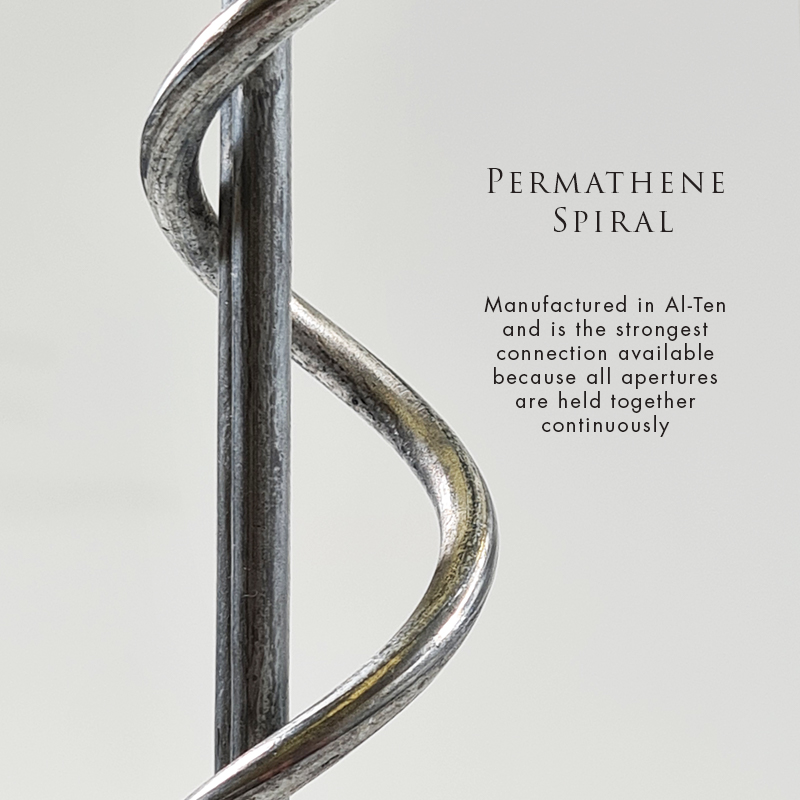
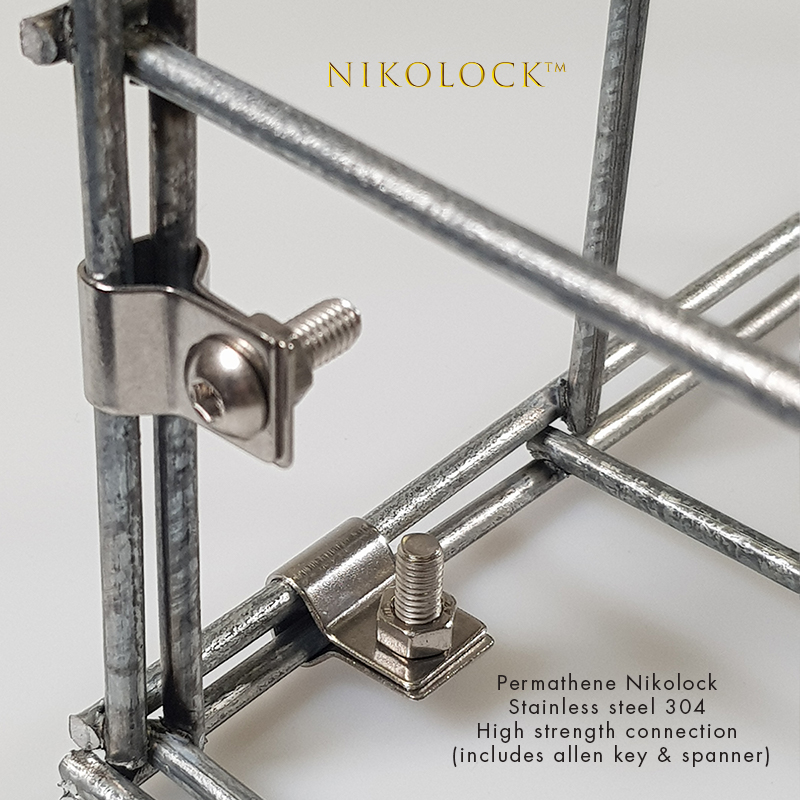

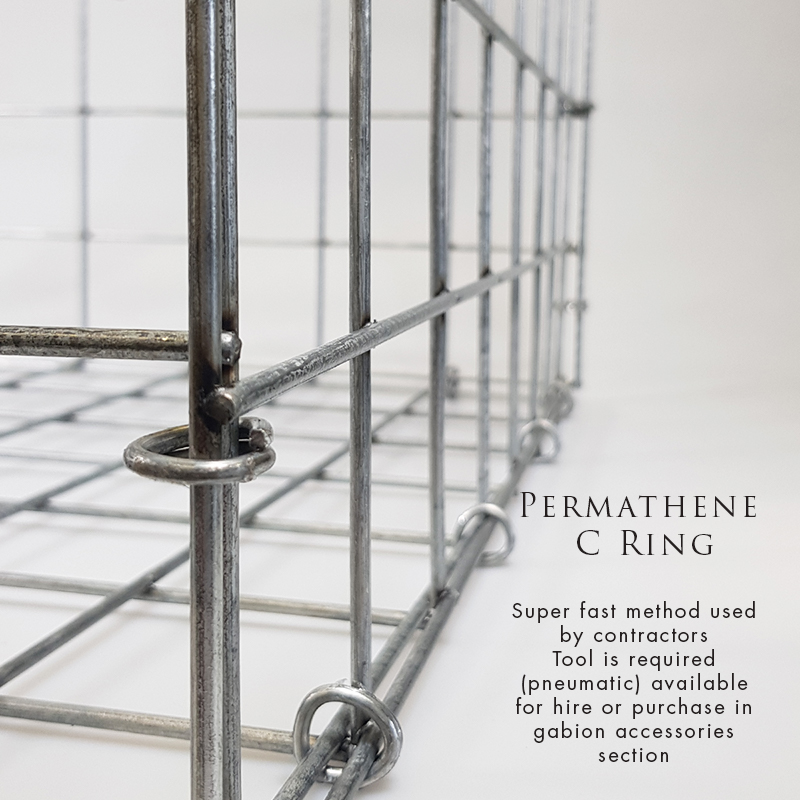
1) Spiral
Spirals are supplied in lengths of 300mm, 500mm, 750mm, 975mm, 1000mm, 1200mm. Each kitset contains a combination depending which size of gabion is ordered.
2) Nikolock
Supplied in stainless steel 316, Nikolock are a new connection method that provides a neat looking finish as they can be placed so as not to be seen. Suitable for 4mm wire only. The installation process can be sped up by using an allen wrench bit inside a cordless drill.
3) U Clip
Supplied in stainless steel 316, U clips are fastened using a U clip plier which is available for purchase or hire (cost is refunded when returned to us for customers buying mesh from us). The U clip is not suitable for large walls due to strength being a lot less than the other methods. These are only suitable for 4mm diameter wire.
4) C Ring
Gabion C rings are 3mm in diameter and 45mm wide. Available in both galfan and stainless steel (304). With a tensile strength of 1700-1900N/mm2 these are a good method to build gabion walls, however they are still not as strong as spirals. To use gabion C rings a pneumatic tools is required. These are available for purchase or rental from us. C rings are a quick method preferred by most landscapers.
Gabion Construction Guides
Gabion Wall Construction Specification
1) Scope
The work shall consist of supply, construction of cages and filling with rock.
2) Types
Permathene Gabions shall consist of square or rectangular welded mesh constructed to form containers filled with rock. The gabion mesh supplied to site shall conform to ASTM 974-97. The weld shear strength is meet a minimum of 50% of wire tensile strength. The wire shall be mild steel coated with 280 gsm (min) Al 10%, Zn 90%. The wire shall have a tensile strength between 350-750 N/mm2.
3) Materials
All connections including spirals and stiffener wires shall be manufactured in Galfan coated mild steel to the same diameter as the mesh. C rings shall be Meihotech, Galfan coated, 3mm diameter, 45mm opening, tensile strength 1700-1900 N/mm2.
INSTALLATION GUIDE
1) Foundation preparation
The foundation on which the gabions are to be placed shall be cut or filled and graded as required. Surface irregularities, loose material, vegetation, and all foreign matter shall be removed from foundation surface area. Gabions and bedding or specified geotextiles shall not be placed until the foundation preparation is completed, and the subgrade surfaces have been inspected and approved by the engineer or the engineer’s representative. Compaction of bedding or filter material will be required per plans and specifications. The surface of the finished material shall be to grade and free of mounds, dips or windrows. Extra care should be taken with foundation preparations in order to ensure a level and smooth surface. Geotextile shall be installed in accordance with the requirements of the plans and specifications.
2) Assembly
The assembly and placement of gabions shall be in accordance with the following procedures: Assembly. Rotate the gabion panels into position and join the vertical edges with fasteners for gabion assembly. Where spiral fasteners are used, crimp the ends to secure the spirals in place. Where C ring type alternate fasteners are used for basket assembly, install the fasteners at a maximum spacing of 150 mm. Use the same fastening procedures to install interior diaphragms where they are required. Interior diaphragms will be required where any inside dimension exceeds 1m for gabion baskets. Diaphragms will be installed to assure that no open intervals are present that exceeds 1m.
3) Placement
Place the empty gabions on the foundation and interconnect the adjacent gabions along the top, bottom, and vertical edges using spirals or C rings.
Modular Assembly
Gabion cages can be built in a modular method by eliminating an end panel for each cage so no two panels need be connected together. The same method may also be used for successive courses including lid and base panels. Interconnect each layer of gabions to the underlying layer of gabions along the front, back, and sides.
4) Filling operation
After adjacent empty wire gabion units are set to line and grade and common sides properly connected, they shall be placed in straight-line tension to gain a uniform alignment. Staking of the gabions may be done to maintain the established proper alignment prior to the placement of rock. No temporary stakes shall be placed through geotextile material. Connecting lacing wire and other fasteners (as allowed) shall be attached during the filling operation to preserve the strength and shape of the structure.
Internal connecting cross-tile (stiffener) wires shall be placed in each unrestrained gabion cell, including gabion cells left temporarily unrestrained. Two internal connecting wires shall be placed concurrently with rock placement, at each 300 mm interval of depth. In welded mesh gabions these cross ties or stiffeners will be placed across the corners of the gabions (at 300 mm from the corners) providing diagonal bracing. Lacing wire or preformed wire stiffeners may be used.
The gabions shall be carefully filled with rock, either by machine or hand methods, ensuring alignment, avoiding bulges, and providing a compact mass that minimizes voids. At no point in the filling process may rock be mechanically placed from a height of over 1m from machine to fill area. Machine placement will require supplementing with handwork to ensure the desired results. The cells in any row shall be filled in stages so that the depth of rock placed in any one cell does not exceed the depth of rock in any adjoining cell by more than 300 mm. Along the exposed faces, the outer layer of stone shall be carefully placed and arranged by hand to ensure a neat, compact placement with a uniform appearance.
The last layer of rock shall be uniformly leveled to the top edges of the gabions. Lids shall be placed over the rock filling using only approved lid closing tools as necessary. The use of crowbars or other single point leverage bars for lid closing is prohibited due to the potential for damage to the baskets.
The gabion lid shall then be secured to the sides, ends, and diaphragms with spiral binders, approved alternate fasteners, or lacing wire wrapped with alternating single and double half hitches in the mesh openings.
Any damage to the wire or coatings during assembly, placement and filling shall be repaired promptly in accordance with the manufacturer’s recommendations or replaced with undamaged gabion baskets.
Gabion Kitset Guide (spiral connection)
Easy to construct. Simply follow the pdf guide (see link at top of page) for the correct placing of stiffener wires.
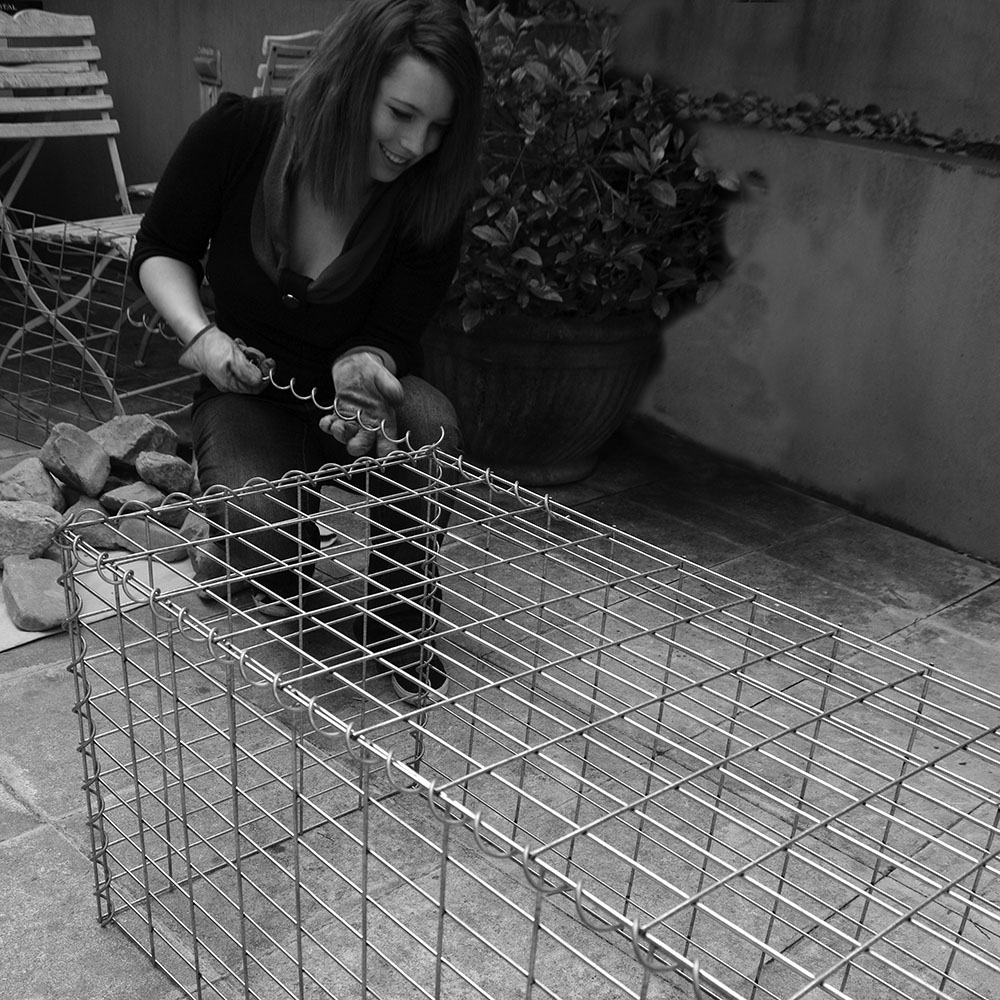
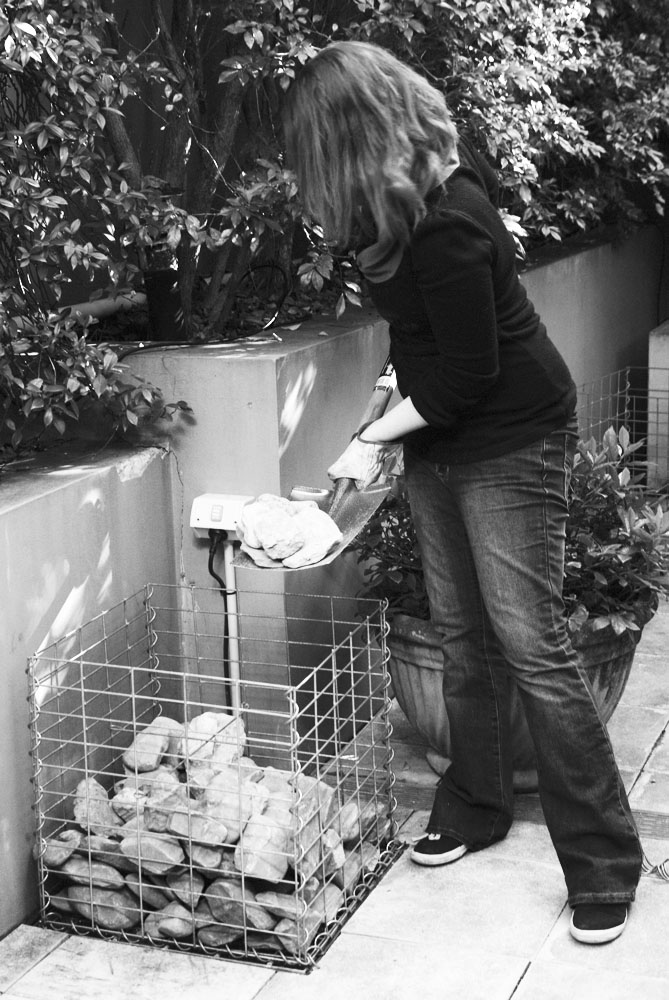
Gabion Tools
Meihotech Gabion C Ringer
The Meihotech C Ring tool is one of the most reliable hog ringers available. Made in Japan it will work where others fail. Highest quality, in stock always. This is a pneumatic tool and requires a compressor. Air consumption is relatively low at under 9.9 litres (0.7Mpa), increase compressor size if working at heights. The compressor needs to maintain a constant pressure of 90-100 psi for standard gabion C rings (Galfan coated mild steel), or 110 psi for stainless steel. Meihotech C ringers have a 12 month warranty. Service is provided by Permathene.
Contractors that service their own pneumatic equipment will find the Meihotech very easy to disassemble and replace parts by following the guides (see pdf's above).
Permathene carries parts and can ship the same day (Fast Post or other urgent couriers).
This C ringer is for gabion and uses C rings which are 3mm in diameter and 45mm at the widest point.
Two strips of 50 C Rings can be loaded onto the Meihotech C Ringer. These C Rings cannot be closed with pliers.
How to use a Gabion C ringer
It is important to use a compressor that can maintain a pressure of 90psi (6-7 bar) at the tool. Pressure from the compressor gauge may not be correct due to hose length and height of work. If the pressure at compressor indicates 90 psi but C rings are not closing properly (they should close to 18mm if trigger depressed and then to 12mm after a few seconds) then it is an indication that pressure is not high enough.
Never use too much pressure, so it is important to increase pressure slowly.

















